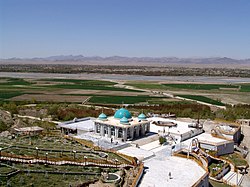Arghandab District, Kandahar
Settlement in Afghanistan From Wikipedia, the free encyclopedia
Arghandab (Pashto/Persian: ارغنداب) is a district in the central part of Kandahar Province, Afghanistan.[1] It borders Panjwai and Khakrez districts to the west, Shah Wali Kot District to the north and east and Kandahar District to the east and south.[2]
This article needs additional citations for verification. (May 2008) |
Arghandab District
ارغنداب | |
|---|---|
 The Shrine of Baba Wali in the Arghandab district. | |
| Coordinates: 31°39′17″N 65°38′58″E | |
| Country | Afghanistan |
| Province | Kandahar Province |
| Center | Town of Arghandab |
| Elevation | 1,112 m (3,648 ft) |
| Population (2006) | |
• Total | 54,900 |
| Time zone | + 4.30 |
| Website | Arghandab.gov |
The population, as of 2006, was 54,900. The district centre is Arghandab, located northwest of Kandahar. The Arghandab River flows through the district in its eastern part West from the district center, and the area is irrigated by the Helmand and Arghandab Valley Authority.[3][4] The climate, river and irrigation allow the inhabitants to aggregate several different forms of produce. The main agricultural crops in this region are pomegranates, grapes, plums, and Cannabis sativa.

History
Arghandab was known as "the gateway to Kandahar." Through the ridges that overlook Kandahar City to the north, the valley was the only viable northern route for commerce or invaders. If Arghandab was held, an invader could not enter the city from the north. In 2007, the Alkozay tribe ruled Arghandab, led by the mujahideen commander, Mullah Naqib. He and his Alkozay had safeguarded the city since 2001. The Arghandab Alkozay had a certain esprit de corps. They were proud of their green district and its pomegranates and grapes. They were even prouder of their warrior history and Mullah Naqib. They saw themselves as one group. If asked his home, a young tribesman would shout back, "Arghandab!" That pride was a powerful check on a Taliban advance on Kandahar-whether in 1994 or 2007.[5]
War in Afghanistan
The district was the site of the Battle of Arghandab in June 2008.
On 16 November 2009, Taliban attackers raided a police station, killing eight officers and wounding three. Three other police officers in the station disappeared, and a spokesman for the Kandahar governor's office, who asked not to be identified by name, said he was not sure if the officers who disappeared had a connection to the Taliban.[6]
On 9 June 2010, a suicide attack at a wedding party in the village of Nagahan of the Arghandab district killed at least 40 people and wounded 77, making it one of the worst attacks of the year.
From November 2020, there have been multiple attempted takeovers of the district by Taliban. As of December 9, 2020, the district remains to be contested, with the Taliban believed to be occupying the area along the western bank and Afghan security forces believed to be occupying the eastern bank (including the Baba Wali Shrine).[7]
On December 24, 2020, Afghan forces recaptured the entirety of the district, killing 37 insurgents in the process.[8]
Notables
- Mullah Naqib
- Shahwali Khan
- Tayyab Agha
- Syed Muhammad Akbar Agha
- Niamatullah Arghandabi
See also
References
Wikiwand - on
Seamless Wikipedia browsing. On steroids.

